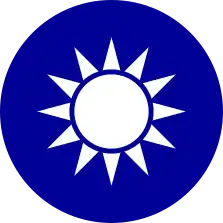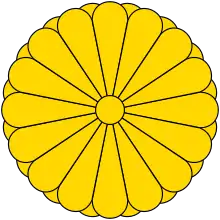Nanjing Massacre
The Nanjing Massacre or the Rape of Nanjing (alternately written as the Nanking Massacre or the Rape of Nanking)[note 1] was an episode of mass murder and mass rape committed by Imperial Japanese troops against the residents of Nanjing (Nanking), at that time the capital of China, during the Second Sino-Japanese War.
| Nanjing Massacre | |||||||
|---|---|---|---|---|---|---|---|
| Part of the Second Sino-Japanese War | |||||||
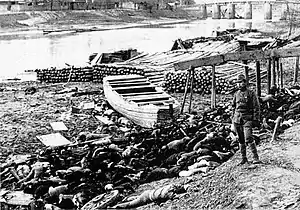 The corpses of massacre victims on the shore of the Qinhuai River with a Japanese soldier standing nearby | |||||||
| |||||||
| Nanjing Massacre | |||||||||
|---|---|---|---|---|---|---|---|---|---|
| Chinese name | |||||||||
| Traditional Chinese | 南京大屠殺 | ||||||||
| Simplified Chinese | 南京大屠杀 | ||||||||
| |||||||||
| Japanese name | |||||||||
| Kanji | 1. 南京大虐殺 2. 南京事件 | ||||||||
| |||||||||
| This article is part of the series on |
| Nanjing Massacre |
|---|
| Japanese war crimes |
| Historiography of the Nanjing Massacre |
| Films |
| Books |
The massacre occurred over a period of six weeks starting on December 13, 1937, the day that the Japanese captured Nanjing. During this period, soldiers of the Imperial Japanese Army murdered disarmed combatants and Chinese civilians numbering an estimated 40,000 to over 300,000,[7][8] and perpetrated widespread rape and looting.[9][10]
Since most Japanese military records on the killings were kept secret or destroyed shortly after the surrender of Japan in 1945, historians have been unable to accurately estimate the death toll of the massacre. In 1946, the International Military Tribunal for the Far East in Tokyo estimated that over 200,000 Chinese were killed in the massacre.[11] China's official estimate is more than 300,000 dead based on the evaluation of the Nanjing War Crimes Tribunal in 1947. The death toll has been contested by scholars since the 1980s.[3][12]
The event remains a contentious political issue and an obstacle in Sino-Japanese relations. The Chinese government has been accused of exaggerating aspects of the massacre such as the death toll by many Japanese; historical negationists and Japanese nationalists go as far as claiming the massacre was fabricated for propaganda purposes.[8][13][14][15][16] The controversy surrounding the massacre remains a central issue in Japanese relations with other East Asian nations, such as South Korea.[17]
The Government of Japan has admitted to the killing of many non-combatants, looting and other violence committed by the Imperial Japanese Army after the fall of Nanjing,[18][19] and Japanese veterans who served there have confirmed that a massacre took place.[20] A small but vocal minority in the Japanese government and society have argued that the death toll was military in nature and that no such crimes ever occurred. Denial of the massacre and revisionist accounts of the killings have become a staple of Japanese nationalism.[21] In Japan, public opinion of the massacre varies but few deny outright that the event occurred.[21]
Military situation
In August 1937, the Japanese army invaded Shanghai where they met strong resistance and suffered heavy casualties. The battle was bloody as both sides faced attrition in urban hand-to-hand combat.[22] By mid-November the Japanese had captured Shanghai with the help of naval and (aerial) bombardment. The General Staff Headquarters in Tokyo initially decided not to expand the war due to the high casualties incurred and the low morale of the troops.[23] Nevertheless, on December 1, headquarters ordered the Central China Area Army and the 10th Army to capture Nanjing, then-capital of the Republic of China.
Relocation of the capital
After losing the Battle of Shanghai, Chiang Kai-shek knew that the fall of Nanjing was a matter of time. He and his staff realized that they could not risk the annihilation of their elite troops in a symbolic but hopeless defense of the capital. To preserve the army for future battles, most of it was withdrawn. Chiang's strategy was to follow the suggestion of his German advisers to draw the Japanese army deep into China and use China's vast territory as a defensive strength. Chiang planned to fight a protracted war of attrition to wear down the Japanese in the hinterland of China.[24]
Strategy for the defense of Nanjing
In a press release to foreign reporters, Tang Shengzhi announced the city would not surrender and would fight to the death. Tang gathered about 100,000 soldiers, largely untrained, including Chinese troops who had participated in the Battle of Shanghai. The Chinese government left for relocation on December 1, and the president left on December 7, leaving the fate of Nanjing to an International Committee led by John Rabe, a German national.
In an attempt to secure permission for this cease-fire from Generalissimo Chiang Kai-shek, Rabe, who was living in Nanjing and had been acting as the Chairman of the Nanking International Safety Zone Committee, boarded the USS Panay on December 9. From this gunboat, Rabe sent two telegrams. The first was to Chiang through an American ambassador in Hankow, asking that Chinese forces "undertake no military operations" within Nanjing. The second telegram was sent through Shanghai to Japanese military leaders, advocating for a three-day ceasefire so that the Chinese could withdraw from the city.
The following day, on December 10, Rabe got his answer from the Generalissimo. The American ambassador in Hankow replied that although he supported Rabe's proposal for a ceasefire, Chiang did not. Rabe says that the ambassador also "sent us a separate confidential telegram telling us that he has been officially informed by the Foreign Ministry in Hankow that our understanding that General Tang agreed to a three-day armistice and the withdrawal of his troops from Nanjing is mistaken, and moreover that Chiang Kai-shek has announced that he is not in a position to accept such an offer." This rejection of the committee's ceasefire plan, in Rabe's mind, sealed the fate of the city. Nanjing had been constantly bombed for days and the Chinese troops that remained there were disheartened and had taken to drinking before the city's inevitable fall.
On December 11, Rabe found that Chinese soldiers were still residing in areas of the Safety Zone, meaning that it became an intended target for Japanese attack despite the majority being innocent civilians. Rabe commented on how efforts to remove these Chinese troops failed and Japanese soldiers began to lob grenades into the refugee zone.[25]
Approach of the Imperial Japanese Army
Japanese war crimes on the march to Nanjing
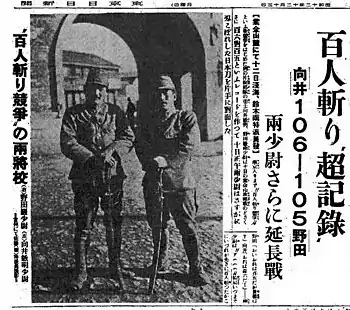

Although the massacre is generally described as having occurred over a six-week period after the fall of Nanjing, the crimes committed by the Japanese army were not limited to that period. Many atrocities were reported to have been committed as the Japanese army advanced from Shanghai to Nanjing.
According to one Japanese journalist embedded with Imperial forces at the time:[27]
The reason that the [10th Army] is advancing to Nanjing quite rapidly is due to the tacit consent among the officers and men that they could loot and rape as they wish.
In his novel Ikiteiru Heitai ('Living Soldiers'), Tatsuzō Ishikawa vividly describes how the 16th Division of the Shanghai Expeditionary Force committed atrocities on the march between Shanghai and Nanjing. The novel itself was based on interviews that Ishikawa conducted with troops in Nanjing in January 1938.[28]
Perhaps the most notorious atrocity was a killing contest between two Japanese officers as reported in the Tokyo Nichi Nichi Shimbun and the English-language Japan Advertiser. The contest—a race between the two officers to see who could kill 100 people first using only a sword—was covered much like a sporting event with regular updates on the score over a series of days.[29][30] In Japan, the veracity of the newspaper article about the contest was the subject of ferocious debate for several decades starting in 1967.[31]
In 2000, historian Bob Tadashi Wakabayashi concurred with certain Japanese scholars who had argued that the contest was a concocted story, with the collusion of the soldiers themselves for the purpose of raising the national fighting spirit.[32]
In 2005, a Tokyo district judge dismissed a suit by the families of the lieutenants, stating that "the lieutenants admitted the fact that they raced to kill 100 people" and that the story cannot be proven to be clearly false.[33] The judge also ruled against the civil claim of the plaintiffs because the original article was more than 60 years old.[34] The historicity of the event remains disputed in Japan.[35]
Retreating Chinese Troops' Scorched-Earth Policy
The Nanjing garrison force set fire to buildings and houses in the areas close to Xiakuan to the north as well as in the environs of the eastern and southern city gates. Targets within and outside of the city walls—such as military barracks, private homes, the Chinese Ministry of Communication, forests and even entire villages—were completely burnt down, at an estimated value of US$20–30 million (1937).[36][37][38]
Establishment of the Nanjing Safety Zone
Many Westerners were living in the city at that time, conducting trade or on missionary trips. As the Japanese army approached Nanjing, most of them fled the city, leaving 27 foreigners. Five of these were journalists who remained in the city a few days after it was captured, leaving the city on December 16. Fifteen of the remaining 22 foreigners formed a committee, called the International Committee for the Nanking Safety Zone in the western quarter of the city.[39]
German businessman John Rabe was elected as its leader, in part because of his status as a member of the Nazi Party and the existence of the German-Japanese bilateral Anti-Comintern Pact. The Japanese government had previously agreed not to attack parts of the city that did not contain Chinese military forces, and the members of the Committee managed to persuade the Chinese government to move their troops out of the area. The Nanking Safety Zone was demarcated through the use of Red Cross Flags[40]
On December 1, 1937, Nanjing Mayor Ma Chaochun ordered all Chinese citizens remaining in Nanjing to move into the "Safety Zone." Many fled the city on December 7, and the International Committee took over as the de facto government of Nanjing.
Prince Asaka appointed as commander
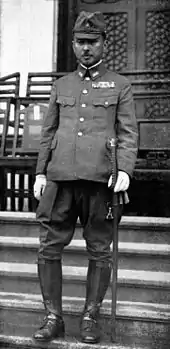
In a memorandum for the palace rolls, Hirohito singled Prince Yasuhiko Asaka out for censure as the one imperial kinsman whose attitude was "not good." He assigned Asaka to Nanjing as an opportunity to make amends.[41] It appears that Hirohito had never learned about, or had refused to admit, Asaka's role in the ensuing massacre.[42]
On December 5, Asaka left Tokyo by plane and arrived at the front three days later. He met with division commanders, lieutenant-generals Kesago Nakajima and Heisuke Yanagawa, who informed him that the Japanese troops had almost completely surrounded 300,000 Chinese troops in the vicinity of Nanjing and that preliminary negotiations suggested that the Chinese were ready to surrender.[43]
Prince Asaka is alleged to have issued an order to "kill all captives," thus providing official sanction for the crimes which took place during and after the battle.[44] Some authors record that Prince Asaka signed the order for Japanese soldiers in Nanjing to "kill all captives".[45] Others assert that lieutenant colonel Isamu Chō, Asaka's aide-de-camp, sent this order under the Prince's sign-manual without the Prince's knowledge or assent.[46] Nevertheless, even if Chō took the initiative, Asaka was nominally the officer in charge and gave no orders to stop the carnage. While the extent of Prince Asaka's responsibility for the massacre remains a matter of debate, the ultimate sanction for the massacre and the crimes committed during the invasion of China were issued in Emperor Hirohito's ratification of the Japanese army's proposition to remove the constraints of international law on the treatment of Chinese prisoners on August 5, 1937.[47]
Battle of Nanjing
Siege of the city
The Japanese military continued to move forward, breaching the last lines of Chinese resistance, and arriving outside the city gates of Nanjing on December 9.
Demand for surrender
At noon on December 9, the Japanese military dropped leaflets into the city, urging the city of Nanjing to surrender within 24 hours, promising "no mercy" if the offer is refused.[48][note 2]
In the meantime, members of the Committee contacted Tang and proposed a plan for three-day cease-fire, during which the Chinese troops could withdraw without fighting while the Japanese troops would stay in their present position.
John Rabe boarded the U.S. gunboat Panay on December 9 and sent two telegrams, one to Chiang Kai-shek by way of the American ambassador in Hankow, and one to the Japanese military authority in Shanghai.
Assault and capture of Nanjing
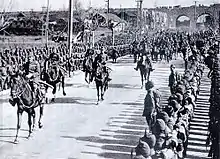
The Japanese awaited an answer to their demand for surrender but no response was received from the Chinese by the deadline on December 10. General Iwane Matsui waited another hour before issuing the command to take Nanjing by force. The Japanese army mounted its assault on the Nanjing walls from multiple directions; the SEF's 16th Division attacked three gates on the eastern side, the 6th Division of the 10A launched its offensive on the western walls, and the SEF's 9th Division advanced into the area in-between.[24]
On December 12, under heavy artillery fire and aerial bombardment, General Tang Sheng-chi ordered his men to retreat. What followed was nothing short of chaos. Some Chinese soldiers stripped civilians of their clothing in a desperate attempt to blend in, and many others were shot by the Chinese supervisory unit as they tried to flee.[36]
On 13 December, the 6th and the 116th Divisions of the Japanese Army were the first to enter the city, facing little military resistance. Simultaneously, the 9th Division entered nearby Guanghua Gate, and the 16th Division entered the Zhongshan and Taiping gates. That same afternoon, two small Japanese Navy fleets arrived on both sides of the Yangtze River.
Pursuit and mopping-up operations
Japanese troops pursued the retreating Chinese army units, primarily in the Xiakuan area to the north of the city walls and around the Zijin Mountain in the east. Although most sources suggest that the final phase of the battle consisted of a one-sided slaughter of Chinese troops by the Japanese, some Japanese historians maintain that the remaining Chinese military still posed a serious threat to the Japanese. Prince Yasuhiko Asaka told a war correspondent later that he was in a very perilous position when his headquarters was ambushed by Chinese forces that were in the midst of fleeing from Nanjing east of the city. On the other side of the city, the 11th Company of the 45th Regiment encountered some 20,000 Chinese soldiers who were making their way from Xiakuan.[24]
The Japanese army conducted its mopping-up operation both inside and outside the Nanking Safety Zone. Since the area outside the safety zone had been almost completely evacuated, the mopping-up effort was concentrated in the safety zone. The safety zone, an area of 3.85 square kilometres, was packed with the remaining population of Nanjing. The Japanese army leadership assigned sections of the safety zone to some units to separate alleged plain-clothed soldiers from the civilians.[24] The number of Chinese soldiers in plain clothes that were executed are estimated to be around 4,000.[49]
Civilian evacuation
Evacuation and flight of civilians
With the relocation of the capital of China and the reports of Japanese brutality, most of the civilian population fled Nanjing out of fear. Wealthy families were the first to flee, leaving Nanjing in automobiles, followed by the evacuation of the middle class and then the poor, while only the destitute lowest class such as the ethnic Tanka boat people remained behind.[50]
More than three quarters of the population had fled Nanjing before the Japanese arrived.[51]
Massacre
Eyewitness accounts of Westerners and Chinese present at Nanjing in the weeks after the fall of the city say that, over the course of six weeks following the fall of Nanjing, Japanese troops engaged in mass rape, murder, torture, theft, arson, and other war crimes. Some of these primary accounts, including the diaries of John Rabe and American Minnie Vautrin, came from foreigners who opted to stay behind to protect the Chinese civilians from harm. Other accounts include first-person testimonies of Nanjing Massacre survivors, eyewitness reports of journalists (both Western and Japanese), as well as the field diaries of military personnel. American missionary John Magee stayed behind to provide a 16 mm film documentary and first-hand photographs of the Nanjing Massacre.
A group of foreign expatriates headed by Rabe had formed a 15-man International Committee for the Nanking Safety Zone on November 22 and mapped out the Nanking Safety Zone in order to safeguard civilians in the city. The city population of Nanjing inflated drastically during the mid-1930s, as many refugees fled from the Japanese aggression in the north.[52] Rabe and American missionary Lewis S. C. Smythe, secretary of the International Committee and a professor of sociology at the University of Nanking, recorded the actions of the Japanese troops and filed complaints with the Japanese embassy.
Massacre contest
In 1937, the Osaka Mainichi Shimbun and its sister newspaper, the Tokyo Nichi Nichi Shimbun, covered a contest between two Japanese officers, Toshiaki Mukai and Tsuyoshi Noda of the Japanese 16th Division. The two men were described as vying to be the first to kill 100 people with a sword before the capture of Nanjing. From Jurong to Tangshan (two cities in Jiangshu Province, China), Mukai had killed 89 people while Noda had killed 78. The contest continued because neither had killed 100 people. By the time they had arrived at Zijin Mountain, Noda had killed 105 people while Mukai had killed 106 people. Both officers supposedly surpassed their goal during the heat of battle, making it impossible to determine which officer had actually won the contest. Therefore, according to journalists Asami Kazuo and Suzuki Jiro, writing in the Tokyo Nichi Nichi Shimbun of December 13, they decided to begin another contest to kill 150 people.[53] After the surrender of Japan in 1945, Mukai and Noda were both arrested and tried as war criminals, and both of them were found guilty and executed by shooting.[54]
Rape
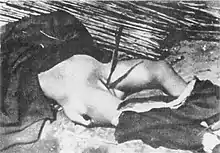
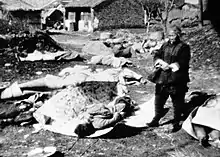
The International Military Tribunal for the Far East estimated that 20,000 women, including some children and the elderly, were raped during the occupation.[57] A large number of rapes were done systematically by the Japanese soldiers as they went from door to door, searching for girls, with many women being captured and gang raped.[58] The women were often killed immediately after being raped, often through explicit mutilation[59] or by penetrating vaginas with bayonets, long sticks of bamboo, or other objects. Young children were not exempt from these atrocities and were cut open to allow Japanese soldiers to rape them.[60]
On 19 December 1937, the Reverend James M. McCallum wrote in his diary:[61]
I know not where to end. Never I have heard or read such brutality. Rape! Rape! Rape! We estimate at least 1,000 cases a night and many by day. In case of resistance or anything that seems like disapproval, there is a bayonet stab or a bullet.… People are hysterical… Women are being carried off every morning, afternoon and evening. The whole Japanese army seems to be free to go and come as it pleases, and to do whatever it pleases.
On March 7, 1938, Robert O. Wilson, a surgeon at the university hospital in the Safety Zone administrated by the United States, wrote in a letter to his family, "a conservative estimate of people slaughtered in cold blood is somewhere about 100,000, including of course thousands of soldiers that had thrown down their arms."[62] Here are two excerpts from his letters of 15 and 18 December 1937 to his family:[63]
The slaughter of civilians is appalling. I could go on for pages telling of cases of rape and brutality almost beyond belief. Two bayoneted corpses are the only survivors of seven street cleaners who were sitting in their headquarters when Japanese soldiers came in without warning or reason and killed five of their number and wounded the two that found their way to the hospital. Let me recount some instances occurring in the last two days. Last night the house of one of the Chinese staff members of the university was broken into and two of the women, his relatives, were raped. Two girls, about 16, were raped to death in one of the refugee camps. In the University Middle School where there are 8,000 people the Japs came in ten times last night, over the wall, stole food, clothing, and raped until they were satisfied. They bayoneted one little boy of eight who [had] five bayonet wounds including one that penetrated his stomach, a portion of omentum was outside the abdomen. I think he will live.
In his diary kept during the aggression against the city and its occupation by the Imperial Japanese Army, the leader of the Safety Zone, John Rabe, wrote many comments about Japanese atrocities. For 17 December:[64]
Two Japanese soldiers have climbed over the garden wall and are about to break into our house. When I appear they give the excuse that they saw two Chinese soldiers climb over the wall. When I show them my party badge, they return the same way. In one of the houses in the narrow street behind my garden wall, a woman was raped, and then wounded in the neck with a bayonet. I managed to get an ambulance so we can take her to Kulou Hospital ... Last night up to 1,000 women and girls are said to have been raped, about 100 girls at Ginling College…alone. You hear nothing but rape. If husbands or brothers intervene, they're shot. What you hear and see on all sides is the brutality and bestiality of the Japanese soldiers.
There are also accounts of Japanese troops forcing families to commit incestuous acts.[65] Sons were forced to rape their mothers, and fathers were forced to rape their daughters.
Iris Chang estimated that the number of Chinese women raped by Japanese soldiers ranged from 20,000 to 80,000. Chang also states that not all rape victims were women. Some Chinese men were sodomized and forced to perform "repulsive sex acts".[66][67]
Massacre of civilians
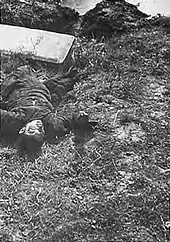
Following the capture of Nanjing, a massacre, which was perpetrated by the Imperial Japanese Army (IJA), led to the deaths of up to 60,000 residents in the city, a figure difficult to precisely calculate due to the many bodies deliberately burnt, buried in mass graves, or deposited in the Yangtze River by the IJA.[68][69][70] Japanese ultra-nationalists have strongly disputed such death tolls, with some claiming that no more than several hundred civilians were killed during the massacre.[71] B. Campbell, in an article published in the journal Sociological Theory, has described the Nanjing Massacre as a genocide, given the fact that residents were still slaughtered en masse during the aftermath, despite the successful and certain outcome in battle.[72] On 13 December 1937, John Rabe wrote in his diary:
It is not until we tour the city that we learn the extent of destruction. We come across corpses every 100 to 200 yards. The bodies of civilians that I examined had bullet holes in their backs. These people had presumably been fleeing and were shot from behind. The Japanese march through the city in groups of ten to twenty soldiers and loot the shops.… I watched with my own eyes as they looted the café of our German baker Herr Kiessling. Hempel's hotel was broken into as well, as [was] almost every shop on Chung Shang and Taiping Road.[73]
On 10 February 1938, Legation Secretary of the German Embassy, Rosen, wrote to his Foreign Ministry about a film made in December by Reverend John Magee to recommend its purchase.
During the Japanese reign of terror in Nanking – which, by the way, continues to this day to a considerable degree – the Reverend John Magee, a member of the American Episcopal Church Mission who has been here for almost a quarter of a century, took motion pictures that eloquently bear witness to the atrocities committed by the Japanese.… One will have to wait and see whether the highest officers in the Japanese army succeed, as they have indicated, in stopping the activities of their troops, which continue even today.[73] On December 13, about 30 soldiers came to a Chinese house at No. 5 Hsing Lu Koo in the southeastern part of Nanking, and demanded entrance. The door was open by the landlord, a Mohammedan named Ha. They killed him immediately with a revolver and also Mrs. Ha, who knelt before them after Ha's death, begging them not to kill anyone else. Mrs. Ha asked them why they killed her husband and they shot her. Mrs. Hsia was dragged out from under a table in the guest hall where she had tried to hide with her 1 year old baby. After being stripped and raped by one or more men, she was bayoneted in the chest, and then had a bottle thrust into her vagina. The baby was killed with a bayonet. Some soldiers then went to the next room, where Mrs. Hsia's parents, aged 76 and 74, and her two daughters aged 16 and 14 [were]. They were about to rape the girls when the grandmother tried to protect them. The soldiers killed her with a revolver. The grandfather grasped the body of his wife and was killed. The two girls were then stripped, the elder being raped by 2–3 men, and the younger by 3. The older girl was stabbed afterwards and a cane was rammed in her vagina. The younger girl was bayoneted also but was spared the horrible treatment that had been meted out to her sister and mother. The soldiers then bayoneted another sister of between 7–8, who was also in the room. The last murders in the house were of Ha's two children, aged 4 and 2 respectively. The older was bayoneted and the younger split down through the head with a sword.[73]
On 5 February 2009, the Japanese Supreme Court ordered Shūdō Higashinakano and the publisher Tendensha to pay four million yen in damages to Mrs. Shuqin Xia, who claims to be the 7- or 8-year-old girl who appears in Magee's film. Higashinakano had claimed in his book, Thorough Review of Nanjing Massacre, that she and the girl were different persons, and that she was not a witness of the Nanjing massacre, but he was unable to prove this at trial.[74]
_01.jpg.webp)
Pregnant women were targeted for murder, as their stomachs were often bayoneted, sometimes after rape. Tang Junshan, survivor and witness to one of the Japanese army's systematic mass killings, testified:[75]
The seventh and last person in the first row was a pregnant woman. The soldier thought he might as well rape her before killing her, so he pulled her out of the group to a spot about ten meters away. As he was trying to rape her, the woman resisted fiercely.… The soldier abruptly stabbed her in the belly with a bayonet. She gave a final scream as her intestines spilled out. Then the soldier stabbed the fetus, with its umbilical cord clearly visible, and tossed it aside.
According to Navy veteran Sho Mitani, "The Army used a trumpet sound that meant 'Kill all Chinese who run away'."[76] Thousands were led away and mass-executed in an excavation known as the "Ten-Thousand-Corpse Ditch", a trench measuring about 300 m long and 5 m wide. Since records were not kept, estimates regarding the number of victims buried in the ditch range from 4,000 to 20,000. However, most scholars and historians consider the number to be more than 12,000 victims.[77]
The Hui people, a minority Chinese group, the majority of them Muslim, suffered as well during the massacre. One mosque was found destroyed and others found to be "filled with dead bodies." Hui volunteers and imams buried over a hundred of their dead following Muslim ritual.[78]
Extrajudicial killing of Chinese prisoners of war
On 5 August 1937, the Deputy Minister of Military of Japan notified Japanese Troops in Shanghai of the army's proposition to remove the constraints of international law on the treatment of Chinese prisoners ("Riku Shi Mitsu No.198"). The directive also advised staff officers to no longer to use the term Prisoner of War.[79]

Soon after the fall of the city, Japanese troops made a thorough search for Chinese soldiers and summarily arrested thousands of young Chinese men. Many were taken to the Yangtze River, where they were machine-gunned to death. What was probably the single largest massacre of Chinese troops, the Straw String Gorge Massacre, occurred along the banks of the Yangtze River on December 18. For most of the morning, Japanese soldiers tied the POWs' hands together. At dusk, the soldiers divided POWs into four columns and opened fire. Unable to escape, the POWs could only scream and thrash desperately. It took an hour for the sounds of death to stop and even longer for the Japanese to bayonet each individual. The majority of the bodies were dumped directly into the Yangtze River.[80]
The Japanese troops gathered 1,300 Chinese soldiers and civilians at Taiping Gate and murdered them. The victims were blown up with landmines, then doused with petrol and set on fire. The survivors were killed with bayonets.[81]
American news correspondents F. Tillman Durdin and Archibald Steele reported seeing corpses of massacred Chinese soldiers forming mounds six feet high at the Nanjing Yijiang gate in the north. Durdin, who worked for The New York Times, toured Nanjing before his departure from the city. He heard waves of machine-gun fire and witnessed the Japanese soldiers gun down some two hundred Chinese within ten minutes. He would later state that he had seen tank guns used on bound soldiers.
Two days later, in his report to The New York Times, Durdin stated that the alleys and street were filled with the dead, amongst them women and children. Durdin stated "[i]t should be said that certain Japanese units exercised restraint and that certain Japanese officers tempered power with generosity and commission," but continued "the conduct of the Japanese army as a whole in Nanjing was a blot on the reputation of their country"."[82][83]
Ralph L. Phillips, a missionary, testified to the U.S. State Assembly Investigating Committee, that he was "forced to watch while the Japs disembowled a Chinese soldier" and "roasted his heart and liver and ate them."[84]
Theft and arson
One-third of the city was destroyed as a result of arson. According to reports, Japanese troops torched newly built government buildings as well as the homes of many civilians. There was considerable destruction to areas outside the city walls. Soldiers pillaged from the poor and the wealthy alike. The lack of resistance from Chinese troops and civilians in Nanjing meant that the Japanese soldiers were free to divide up the city's valuables as they saw fit. This resulted in the widespread looting and burglary.[85]
On 17 December, chairman John Rabe wrote a complaint to Kiyoshi Fukui, second secretary of the Japanese Embassy. The following is an excerpt:
In other words, on the 13th when your troops entered the city, we had nearly all the civilian population gathered in a Zone in which there had been very little destruction by stray shells and no looting by Chinese soldiers even in full retreat.… All 27 Occidentals in the city at that time and our Chinese population were totally surprised by the reign of robbery, raping and killing initiated by your soldiers on the 14th. All we are asking in our protest is that you restore order among your troops and get the normal city life going as soon as possible. In the latter process we are glad to cooperate in any way we can. But even last night between 8 and 9 p.m. when five Occidental members of our staff and Committee toured the Zone to observe conditions, we did not find any single Japanese patrol either in the Zone or at the entrances![86]
Nanking Safety Zone and the role of foreigners
The Japanese troops did respect the Zone to an extent; until the Japanese occupation, no shells entered that part of the city except a few stray shots. During the chaos following the attack of the city, some were killed in the Safety Zone, but the crimes that occurred in the rest of the city were far greater by all accounts.[87]
Rabe wrote that, from time to time, the Japanese would enter the Safety Zone at will, carry off a few hundred men and women, and either summarily execute them or rape and then kill them.[88]
By February 5, 1938, the International Committee for the Nanking Safety Zone had forwarded to the Japanese embassy a total of 450 cases of murder, rape, and general disorder by Japanese soldiers that had been reported after the American, British and German diplomats had returned to their embassies:[89]
- "Case 5 – On the night of December 14th, there were many cases of Japanese soldiers entering houses and raping women or taking them away. This created panic in the area and hundreds of women moved into the Ginling College campus yesterday."
- "Case 10 – On the night of December 15th, a number of Japanese soldiers entered the University of Nanjing buildings at Tao Yuen and raped 30 women on the spot, some by six men."
- "Case 13 – December 18, 4 p.m., at No. 18 I Ho Lu, Japanese soldiers wanted a man's cigarette case and when he hesitated, one of the soldier crashed in the side of his head with a bayonet. The man is now at the University Hospital and is not expected to live."
- "Case 14 – On December 16, seven girls (ages ranged from 16 to 21) were taken away from the Military College. Five returned. Each girl was raped six or seven times daily- reported December 18th."
- "Case 15 – There are about 540 refugees crowded in No. 83 and 85 on Canton Road.… More than 30 women and girls have been raped. The women and children are crying all nights. Conditions inside the compound are worse than we can describe. Please give us help."
- "Case 16 – A Chinese girl named Loh, who, with her mother and brother, was living in one of the Refugee Centers in the Refugee Zone, was shot through the head and killed by a Japanese soldier. The girl was 14 years old. The incident occurred near the Kuling Ssu, a noted temple on the border of the Refugee zone ..."[89]
- "Case 19 – January 30th, about 5 p.m. Mr. Sone (of the Nanjing Theological Seminary) was greeted by several hundred women pleading with him that they would not have to go home on February 4th. They said it was no use going home they might just as well be killed for staying at the camp as to be raped, robbed or killed at home.… One old woman 62 years old went home near Hansimen and Japanese soldiers came at night and wanted to rape her. She said she was too old. So the soldiers rammed a stick up her. But she survived to come back."
It is said that Rabe rescued between 200,000 and 250,000 Chinese people.[90][91]
Causes
Jonathan Spence writes:[92]
[T]here is no obvious explanation for this grim event, nor can one be found. The Japanese soldiers, who had expected easy victory, instead had been fighting hard for months and had taken infinitely higher casualties than anticipated. They were bored, angry, frustrated, tired. The Chinese women were undefended, their menfolk powerless or absent. The war, still undeclared, had no clear-cut goal or purpose. Perhaps all Chinese, regardless of sex or age, seemed marked out as victims.
.jpg.webp) Photo in the album taken in Nanjing by Itou Kaneo of the Kisarazu Air Unit of the Imperial Japanese Navy
Photo in the album taken in Nanjing by Itou Kaneo of the Kisarazu Air Unit of the Imperial Japanese Navy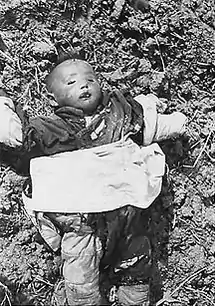 A picture of a dead child. Probably taken by Bernhard Sindberg
A picture of a dead child. Probably taken by Bernhard Sindberg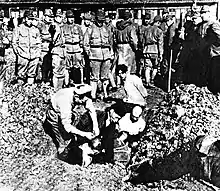 Prisoners being buried alive[93]
Prisoners being buried alive[93]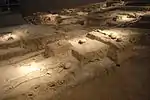 Skeletons of the massacre's victims
Skeletons of the massacre's victims
Matsui's reaction to the massacre
On December 18, 1937, as General Iwane Matsui began to comprehend the full extent of the rape, murder, and looting in the city, he grew increasingly dismayed. He reportedly told one of his civilian aides:
I now realize that we have unknowingly wrought a most grievous effect on this city. When I think of the feelings and sentiments of many of my Chinese friends who have fled from Nanjing and of the future of the two countries, I cannot but feel depressed. I am very lonely and can never get in a mood to rejoice about this victory.… I personally feel sorry for the tragedies to the people, but the Army must continue unless China repents. Now, in the winter, the season gives time to reflect. I offer my sympathy, with deep emotion, to a million innocent people.
On New Year's Day, over a toast he confided to a Japanese diplomat: "My men have done something very wrong and extremely regrettable."[94]
End of the massacre
In late January 1938, the Japanese army forced all refugees in the Safety Zone to return home, immediately claiming to have "restored order". After the establishment of the weixin zhengfu (the collaborating government) in 1938, order was gradually restored in Nanjing and atrocities by Japanese troops lessened considerably.
On 18 February 1938, the International Committee for the Nanking Safety Zone was forcibly renamed the Nanking International Rescue Committee, and the Safety Zone effectively ceased to function. The last refugee camps were closed in May 1938.
Recall of Matsui and Asaka
In February 1938, both Prince Asaka and General Matsui were recalled to Japan. Matsui returned to retirement, but Prince Asaka remained on the Supreme War Council until the end of the war in August 1945. He was promoted to the rank of general in August 1939, though he held no further military commands.[44]
Death toll estimates
Estimates of the number of victims vary based on the definitions of the geographical range and the duration of the event.
The extent of the atrocities is debated,[70] with numbers ranging from some Japanese claims of several hundred,[71] to the Chinese claim of a non-combatant death toll of 300,000.[68] Historian Tokushi Kasahara states "more than 100,000 and close to 200,000, or maybe more", referring to his own book.[95] This estimation includes the surrounding area outside of the city of Nanjing, which is objected to by a Chinese researcher (the same book, p. 146). Hiroshi Yoshida concludes "more than 200,000" in his book.[96] Tomio Hora writes of 50,000–100,000 deaths.[97]
Mainstream scholars consider figures from 40,000 to over 300,000 to be an accurate estimate. According to the International Military Tribunal for the Far East, estimates made at a later date indicate that the total number of civilians and prisoners of war murdered in Nanjing and its vicinity during the first six weeks of the Japanese occupation was up to 200,000. These estimates are borne out by the figures of burial societies and other organizations, which testify to over 155,000 buried bodies. These figures also do not take into account those persons whose bodies were destroyed by burning, drowning or other means, or whose bodies were interred in mass graves.[69]
According to the verdict of the Nanjing War Crimes Tribunal on 10 March 1947, there are "more than 190,000 mass slaughtered civilians and Chinese soldiers killed by machine gun by the Japanese army, whose corpses have been burned to destroy proof. Besides, we count more than 150,000 victims of barbarian acts buried by the charity organizations. We thus have a total of more than 300,000 victims."[98] However, this estimate includes an accusation that the Japanese Army murdered 57,418 Chinese POWs at Mufushan, though the latest research indicates that between 4,000 and 20,000 were massacred,[99][100] and it also includes the 112,266 corpses allegedly buried by the Chongshantang, a charitable association, though today mainstream historians agree that the Chongshantang's records were at least greatly exaggerated if not entirely fabricated.[101][102][103] Bob Wakabayashi concludes from this that estimates of over 200,000 are not credible.[102] Ikuhiko Hata considers the number 300,000 to be a "symbolic figure" representative of China's wartime suffering and not a figure to be taken literally.[104]
Some researchers estimate that between 40,000 and 60,000 people were killed, which corresponds to the figures from three sources; one is the Red Army's official journal of the time, Hangdibao and another is that of Miner Searle Bates of the International Safety Zone Committee, and the third is the aforementioned figure written by John Rabe in a letter.[1] John Rabe, Chairman of the International Committee for the Nanking Safety Zone, estimated that between 50,000 and 60,000 (civilians) were killed.[2] However, Erwin Wickert, the editor of The diaries of John Rabe, points out that "It is likely that Rabe's estimate is too low, since he could not have had an overview of the entire municipal area during the period of the worst atrocities. Moreover, many troops of captured Chinese soldiers were led out of the city and down to the Yangtze, where they were summarily executed. But, as noted, no one actually counted the dead."
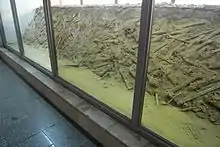
The casualty count of 300,000 was first promulgated in January 1938 by Harold Timperley, a journalist in China during the Japanese invasion, based on reports from contemporary eyewitnesses.[2] Other sources, including Iris Chang's The Rape of Nanking, also conclude that the death toll reached 300,000. In December 2007, newly declassified U.S. government archive documents revealed that a telegraph by the U.S. ambassador to Germany in Berlin sent one day after the Japanese army occupied Nanjing, stated that he heard the Japanese ambassador in Germany boasting that the Japanese army had killed 500,000 Chinese soldiers and civilians as the Japanese army advanced from Shanghai to Nanjing. According to the archives research "The telegrams sent by the U.S. diplomats [in Berlin] pointed to the massacre of an estimated half a million people in Shanghai, Suzhou, Jiaxing, Hangzhou, Shaoxing, Wuxi and Changzhou".[105][106]
In the 2010 Japan-China Joint History Research Committee meeting, scholars from the Japanese side set the maximum possible number of civilian victims at 200,000, with estimates of around 40,000 or 20,000. The Chinese scholars of the committee maintained that at least 300,000 were killed.[107]
Range and duration
The most conservative viewpoint is that the geographical area of the incident should be limited to the few km2 of the city known as the Safety Zone, where the civilians gathered after the invasion. Many Japanese historians have insisted that during the Japanese invasion there were only 200,000–250,000 citizens in Nanjing as reported by John Rabe, to argue that the PRC's estimate of 300,000 deaths is an exaggeration.
Many historians include a much larger area around the city. Including the Xiaguan district (the suburbs north of Nanjing, about 31 km2 in size) and other areas on the outskirts of the city, the population of greater Nanjing was between 535,000 and 635,000 civilians and soldiers just before the Japanese occupation.[108] Some historians also include six counties around Nanjing, known as the Nanjing Special Municipality.
The duration of the incident is naturally defined by its geography: the earlier the Japanese entered the area, the longer the duration. The Battle of Nanking ended on December 13, when the divisions of the Japanese Army entered the walled city of Nanjing. The Tokyo War Crime Tribunal defined the period of the massacre to the ensuing six weeks. More conservative estimates say that the massacre started on December 14, when the troops entered the Safety Zone, and that it lasted for six weeks. Historians who define the Nanjing Massacre as having started from the time that the Japanese Army entered Jiangsu province push the beginning of the massacre to around mid-November to early December (Suzhou fell on November 19), and extended the end of the massacre to late March 1938.
To many Japanese scholars, post-war estimations were distorted by "victor's justice", when Japan was condemned as the sole aggressor. They believed the 300,000 toll typified a "Chinese-style exaggeration" with disregard for evidence. Yet, in China, this figure has come to symbolize the justice, legality, and authority of the post-war trials condemning Japan as the aggressor.[109]
Various estimates
Japanese historians, depending on their definition of the geographical and time duration of the killings, give wide-ranging estimates for the number of massacred civilians, from several thousand to upwards of 200,000.[110] The lowest estimate by a Japanese historian is 40,000.[111]
Chinese language newspapers tend to claim that the massacred civilians and unarmed soldiers may be as high as 200,000.[110]
200,000 Nanjing population debate
Japanese sources assert that there was a population of only 200,000 in Nanjing, thus making the 300,000 death toll impossible. In 2003, Zhang Lianhong, professor of Nanjing Massacre Research Center in Nanjing Normal University, published an article in the Beijing Daily in which he used historical facts to show that the population of Nanjing urban area was between 367,000 and 467,000, and the overall Nanjing population was between 535,000 and 635,000, to refute the assertion of a population of 200,000.[112]
War crimes tribunals
Shortly after the surrender of Japan, the primary officers in charge of the Japanese troops at Nanjing were put on trial. General Matsui was indicted before the International Military Tribunal for the Far East for "deliberately and recklessly" ignoring his legal duty "to take adequate steps to secure the observance and prevent breaches" of the Hague Convention. Hisao Tani, the lieutenant general of the 6th Division of the Imperial Japanese Army in Nanjing, was tried by the Nanjing War Crimes Tribunal.
Other Japanese military leaders in charge at the time of the Nanjing Massacre were not tried. Prince Kan'in Kotohito, chief of staff of the Imperial Japanese Army during the massacre, had died before the end of the war in May 1945. Prince Asaka was granted immunity because of his status as a member of the imperial family.[113][114] Isamu Chō, the aide to Prince Asaka, and whom some historians believe issued the "kill all captives" memo, had committed suicide during the Battle of Okinawa.[115]
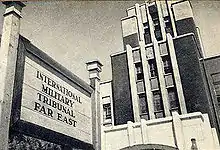 The International Military Tribunal for the Far East was convened at "Ichigaya Court," formally Imperial Japanese Army HQ building in Ichigaya, Tokyo.
The International Military Tribunal for the Far East was convened at "Ichigaya Court," formally Imperial Japanese Army HQ building in Ichigaya, Tokyo. General Iwane Matsui[116]
General Iwane Matsui[116]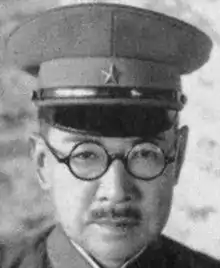 General Hisao Tani[117]
General Hisao Tani[117]
Grant of immunity to Prince Asaka
On May 1, 1946, SCAP officials interrogated Prince Asaka, who was the ranking officer in the city at the height of the atrocities, about his involvement in the Nanjing Massacre and the deposition was submitted to the International Prosecution Section of the Tokyo tribunal. Asaka denied the existence of any massacre and claimed never to have received complaints about the conduct of his troops.[118]
Evidence and testimony
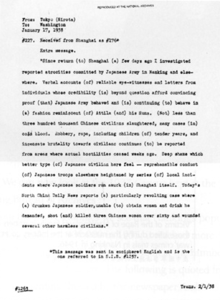
The prosecution began the Nanjing phase of its case in July 1946. Dr. Robert O. Wilson, a surgeon and a member of the International Committee for the Nanking Safety Zone, took the witness stand first. Other members of the International Committee for the Nanking Safety Zone who took the witness stand included Miner Searle Bates and John Magee. George A. Fitch, Lewis S. C. Smythe, and James McCallum filed affidavits with their diaries and letters.
Another piece of evidence that was submitted to the tribunal was Harold Timperley's telegram regarding the Nanjing Massacre which had been intercepted and decoded by the Americans on January 17, 1938. One of the books by Hsü, Documents of the Nanking Safety Zone, was also adduced in court.
The entry for the same day in Matsui's diary read, "I could only feel sadness and responsibility today, which has been overwhelmingly piercing my heart. This is caused by the Army's misbehaviors after the fall of Nanjing and failure to proceed with the autonomous government and other political plans."
Matsui's defense
Matsui asserted that he had never ordered the execution of Chinese POWs. He further argued that he had directed his army division commanders to discipline their troops for criminal acts, and was not responsible for their failure to carry out his directives. At trial, Matsui went out of his way to protect Prince Asaka by shifting blame to lower ranking division commanders.[119]
Verdict
Kōki Hirota, who had been the Foreign Minister when Japan conquered Nanjing, was convicted of participating in "the formulation or execution of a common plan or conspiracy" (count 1), waging "a war of aggression and a war in violation of international laws, treaties, agreements and assurances against the Republic of China" (count 27) and count 55. Matsui was convicted by a majority of the judges at the Tokyo tribunal who ruled that he bore ultimate responsibility for the "orgy of crime" at Nanjing because, "He did nothing, or nothing effective, to abate these horrors."
Organized and wholesale murder of male civilians was conducted with the apparent sanction of the commanders on the pretext that Chinese soldiers had removed their uniforms and were mingling with the population. Groups of Chinese civilians were formed, bound with their hands behind their backs, and marched outside the walls of the city where they were killed in groups by machine gun fire and with bayonets. --- From Judgment of the International Military Tribunal
Sentence
On November 12, 1948, Matsui and Hirota, along with five other convicted Class-A war criminals, were sentenced to death by hanging. Eighteen others received lesser sentences. The death sentence imposed on Hirota, a six-to-five decision by the eleven judges, shocked the general public and prompted a petition on his behalf, which soon gathered over 300,000 signatures but did not succeed in commuting the Minister's sentence.[120][121]
General Hisao Tani was sentenced to death by the Nanjing War Crimes Tribunal.[119]
Memorials
- In 1985, the Nanjing Massacre Memorial Hall was built by the Nanjing Municipal Government in remembrance of the victims and to raise awareness of the Nanjing Massacre. It is located near a site where thousands of bodies were buried, called the "pit of ten thousand corpses" (wàn rén kēng). As of December 2016, there are total 10,615 Nanjing Massacre victim names inscribed on a memorial wall.[122]
- In 1995, Daniel Kwan held a photograph exhibit in Los Angeles titled, "The Forgotten Holocaust".
- In 2005, John Rabe's former residence in Nanjing was renovated and now accommodates the "John Rabe and International Safety Zone Memorial Hall", which opened in 2006.
- On December 13, 2009, both the Chinese and Japanese monks held religious assembly to mourn Chinese civilians killed by invading Japanese troops.[123]
- On December 13, 2014, China held its first Nanjing Massacre memorial day.[124]
On October 9, 2015, Documents of Nanjing Massacre have been listed on the UNESCO Memory of the World Register.[125]
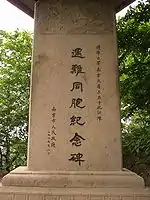 Yanziji Nanjing Massacre Memorial in 2004
Yanziji Nanjing Massacre Memorial in 2004 A memorial stone at Yanziji in Nanjing, for victims in the Nanjing Massacre
A memorial stone at Yanziji in Nanjing, for victims in the Nanjing Massacre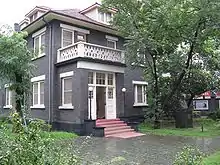 John Rabe's former residence, now the "John Rabe and International Safety Zone Memorial Hall", in Nanjing, July 2008
John Rabe's former residence, now the "John Rabe and International Safety Zone Memorial Hall", in Nanjing, July 2008
Controversy
China and Japan have both acknowledged the occurrence of wartime atrocities.[126] Disputes over the historical portrayal of these events continue to cause tensions between Japan on one side and China and other East Asian countries on the other side.[127]
Cold War
Before the 1970s, China did relatively little to draw attention to the Nanjing massacre. In her book Rape of Nanking, Iris Chang asserted that the politics of the Cold War encouraged Chairman Mao to stay relatively silent about Nanjing in order to keep a trade relationship with Japan.[128]
Debate in Japan
The debate concerning the massacre took place mainly in the 1970s. During this time, the Chinese government's statements about the event were attacked by the Japanese because they were said to rely too heavily on personal testimonies and anecdotal evidence. Aspersions were cast regarding the authenticity and accuracy of burial records and photographs presented in the Tokyo War Crime Court, which the Japanese government claimed were fabrications by the Chinese government, artificially manipulated or incorrectly attributed to the Nanjing Massacre.[129]
During the 1970s, Katsuichi Honda wrote a series of articles for the Asahi Shimbun on war crimes committed by Japanese soldiers during World War II (such as the Nanjing Massacre).[130] The publication of these articles triggered a vehement response from Japanese right-wingers regarding the Japanese treatment of the war crimes. In response, Shichihei Yamamoto[131] and Akira Suzuki[132] wrote two controversial yet influential articles which sparked the Japanese Negationist movement.
In 1984, in an attempt to refute the allegations of war crimes in Nanjing, the Japanese Army Veterans Association (Kaikosha) interviewed former Japanese soldiers who had served in the Nanjing area from 1937 to 1938. Instead of refuting the allegations, the interviewed veterans confirmed that a massacre had taken place and openly described and admitted to taking part in the atrocities. The results of the survey were published in the association's magazine, Kaiko, in 1985 along with an admission and apology that read, "Whatever the severity of war or special circumstances of war psychology, we just lose words faced with this mass illegal killing. As those who are related to the prewar military, we simply apologize deeply to the people of China. It was truly a regrettable act of barbarity."[20]
Apology and condolences by the Prime Minister and Emperor of Japan
On August 15, 1995, the fiftieth anniversary of the Surrender of Japan, the Japanese prime minister Tomiichi Murayama gave the first formal apology for Japanese actions during the war.
He offered his apology to all survivors and to the relatives and friends of the victims. That day, the prime minister and the Japanese Emperor Akihito pronounced statements of mourning at Tokyo's Nippon Budokan. Iris Chang, author of The Rape of Nanking, criticized Murayama for not providing the written apology that had been expected. She said that the people of China "don't believe that an... unequivocal and sincere apology has ever been made by Japan to China" and that a written apology from Japan would send a better message to the international community.[19]
Denials of the massacre by public officials in Japan
In May 1994, Justice Minister Shigeto Nagano called the Nanjing Massacre a "fabrication".[133]
On June 19, 2007, a group of around 100 Liberal Democratic Party (LDP) lawmakers again denounced the Nanjing Massacre as a fabrication, arguing that there was no evidence to prove the allegations of mass killings by Japanese soldiers. They accused Beijing of using the alleged incident as a "political advertisement".[134][135]
On February 20, 2012, Takashi Kawamura, mayor of Nagoya, told a visiting delegation from Nanjing that the massacre "probably never happened". Two days later he defended his remarks, saying, "Even since I was a national Diet representative, I have said [repeatedly] there was no [Nanjing] massacre that resulted in murders of several hundred thousands of people."[136][137] On April 1, 2013, Kawamura said his position remained unchanged when the issue came up during an election debate.[138]
On February 24, 2012, Tokyo governor Shintaro Ishihara said that he also believes that the Nanjing massacre never happened. He reportedly claims it would have been impossible to kill so many people in such a short period of time.[139] He believes the actual death toll was 10,000.[140]
On February 3, 2014, Naoki Hyakuta, a member of the board of governors of Japan's public broadcasting company, NHK, was quoted as saying the massacre never occurred.[141] He said that there were isolated incidents of brutality but no widespread atrocity, and criticized the Tokyo Trials figure of 200,000.[142]
Legacy
Effect on international relations
The memory of the Nanjing Massacre has been a point of contention in Sino-Japanese relations since the early 1970s.[143] Trade between the two nations is worth over $200 billion annually. Despite this, many Chinese people still have a strong sense of mistrust and animosity toward Japan that originates from the memory of Japanese war crimes such as the Nanjing Massacre. This sense of mistrust is strengthened by the belief that Japan is unwilling to admit to and apologize for the atrocities.[144]
Takashi Yoshida described how changing political concerns and perceptions of the "national interest" in Japan, China, and the U.S. have shaped collective memory of the Nanjing massacre. Yoshida contended that over time the event has acquired different meanings to different people. People from mainland China saw themselves as the victims. For Japan, it was a question they needed to answer, but were reluctant to do so because they too identified themselves as victims after the A-bombs. The U.S., which served as the melting pot of cultures and is home to descendants of members of both of Chinese and Japanese cultures, took up the mantle of investigator for the victimized Chinese. Yoshida has argued that the Nanjing Massacre has figured in the attempts of all three nations as they work to preserve and redefine national and ethnic pride and identity, assuming different kinds of significance based on each country's changing internal and external enemies.[145]
Many Japanese prime ministers have visited the Yasukuni Shrine, a shrine for Japanese war deaths up until the end of the Second World War, which includes war criminals that were involved in the Nanjing Massacre. In the museum adjacent to the shrine, a panel informs visitors that there was no massacre in Nanjing, but that Chinese soldiers in plain clothes were "dealt with severely". In 2006 former Japanese prime minister Junichiro Koizumi made a pilgrimage to the shrine despite warnings from China and South Korea. His decision to visit the shrine regardless sparked international outrage. Although Koizumi denied that he was trying to glorify war or historical Japanese militarism, the Chinese Foreign Ministry accused Koizumi of "wrecking the political foundations of China-Japan relations". An official from South Korea said they would summon the Tokyo ambassador to protest.[146][147][148][149]
As a component of national identity
Yoshida asserts that "Nanjing has figured in the attempts of all three nations [China, Japan and the United States] to preserve and redefine national and ethnic pride and identity, assuming different kinds of significance based on each country's changing internal and external enemies."[150]
Japan
In Japan, the Nanjing Massacre touches upon national identity and notions of "pride, honor and shame". Yoshida argues that "Nanking crystallizes a much larger conflict over what should constitute the ideal perception of the nation: Japan, as a nation, acknowledges its past and apologizes for its wartime wrongdoings; or ... stands firm against foreign pressures and teaches Japanese youth about the benevolent and courageous martyrs who fought a just war to save Asia from Western aggression."[151] Recognizing the Nanjing Massacre as such can be viewed in some circles in Japan as "Japan bashing" (in the case of foreigners) or "self-flagellation" (in the case of Japanese).
The government of Japan believes it can not be denied that the killing of a large number of noncombatants, looting and other acts by the Japanese army occurred. However, the actual number of victims is hard to determine, according to government of Japan.[152] In the 2010 Japan-China Joint History Research Committee meeting, scholars from the Japanese side set the maximum possible number of civilian victims at 200,000, with estimates of around 40,000 or 20,000. The Chinese scholars of the committee maintained that at least 300,000 were killed.[107][153] The range of the death toll estimated by Japanese historians is from tens of thousands to 200,000.[154][155]
According to a brief reference to Nanjing at the Yasukuni museum in Tokyo, the Japanese general in charge gave his men maps showing foreign settlements and a civilian "safety zone", and ordered them to maintain strict military discipline. The visitor is left to assume they did. The museum notes only that "Chinese soldiers disguised in civilian clothes, which numbered around 4000[49] were severely prosecuted".
This nationalist view does not, however, represent a widely shared understanding of what happened at Nanjing, as illustrated by Japanese textbooks' rather different treatment of the atrocity. While the books' take on Nanjing is stilted and feels like the product of a committee, in various versions they acknowledge the deaths of thousands of Chinese including women and children, as well as looting, arson and assaults by Japanese soldiers. They do not mention sexual assaults.
"During this period, when the Japanese Army occupied Nanjing it killed a large number of Chinese and carried out looting, arson and assaults. In regard to the number of victims of this Nanjing Massacre ... the Tokyo (War Crime) Trials later found it in excess of 200,000, and prosecuted Japan's responsibility severely", reads one Japanese textbook.[156]
Another history textbook prepared by the Japanese Society for History Textbook Reform, which had been approved by the government in 2001, attempts to whitewash Japan's war record during the 1930s and early 1940s. It referred to the Nanjing massacre as an "incident", and glossed over the issue of comfort women.[157] Indeed, there is only one sentence that refers to this event: "they [the Japanese troops] occupied that city in December."[158]
China
The Nanjing massacre has emerged as one fundamental keystone in the construction of the modern Chinese national identity.[159] Modern Chinese (including citizens of the PRC, Taiwan, and overseas) will refer to the Nanjing Massacre to explain certain stances they hold or ideas they have; this "national unifying event" holds true to middle-school educated peasants and to senior government officials alike.
Australia
Dockworkers in Australia were horrified at the massacre, and refused to load pig iron onto ships heading for Japan, leading to the Dalfram Dispute of 1938.[160]
In popular culture
Digital archive
- "The Nanking Massacre Project: A Digital Archive of Documents & Photographs from American Missionaries Who Witnessed the Rape of Nanking". The Special Collections of the Yale Divinity School Library.
Films
- Nanking (1938), a war propaganda film released by the Japanese government. This film, rediscovered in 1995, appears to portray a peacefully occupied Nanking, but the film professor Jinshi Fujii has expressed doubts that the location being shown is actually Nanking, and about the content of the film generally.[161]
- The Battle of China (1944) a documentary film by American director Frank Capra.[162] The footage of Nanking atrocities in this film may be sourced to a Chinese-made documentary which Prince Mikasa showed to Hirohito, but which has since been lost.[163]
- Black Sun: The Nanking Massacre (1995), by Chinese director Mou Tun-fei, recreates the events of the Nanking Massacre.
- Don't Cry, Nanking (aka Nanjing 1937) (1995) directed by Wu Ziniu is a historical fiction centering on a Chinese doctor, his Japanese wife, and their children, as they experience the siege, fall, and massacre of Nanking.
- Horror in the East (2000),[164] a documentary film produced by Laurence Rees for BBC, an examination of atrocities and depredations committed by Imperial Japanese military forces, from 1931 to 1945. Includes Japanese film of indoctrination (Emperor worship, Chinese as subhuman) and brutal training of their armed forces, as well as film of the Nanking Massacre itself taken by John Magee.
- The Tokyo Trial (2006) is about the International Military Tribunal for the Far East.
- The Children of Huang Shi (film) (2008) is inspired by the story of the English journalist George Hogg who took pictures of the Nanking Massacre, escaped death by beheading, and fled to the orphanage in Huang Shi.
- Nanking (2007), directed by Bill Guttentag and Dan Sturman, that makes use of letters and diaries from the era as well as archive footage and interviews with surviving victims and those involved in the massacre
- The Truth about Nanjing (2007),[165] a documentary by Satoru Mizushima denying that any such massacre took place
- City of Life and Death (2009) directed by Lu Chuan, a dramatization of the Nanking Massacre
- John Rabe (2009) directed by Florian Gallenberger, a Sino-German co-production about the life of John Rabe, featuring Ulrich Tukur in the title role and Steve Buscemi in a supporting role[166][167]
- Torn Memories of Nanjing (2009) directed by Tamaki Matsuoka. Documentary featuring interviews with Japanese soldiers who admit to raping and killing Chinese civilians, and accounts by Chinese survivors.
- The Flowers of War (2011), directed by Zhang Yimou and starring Christian Bale and Shigeo Kobayashi based on The 13 Women of Nanjing by Geling Yan
Fiction
- Buck, Pearl S. (1942). Dragon Seed. John Day.
- Chand, Meira (1996). A Choice of Evils. London: The Orion Publishing Company.
- Hayder, Mo (2005). "The Devil of Nanking". Tokyo (First ed.). Britain: Bantam Press/Transworld Publishers.
- Jin, Ha (2011). Nanjing Requiem. New York: Pantheon.
- Qi, Shouhua (2005). When the Purple Mountain Burns: A Novel. San Francisco: Long River Press.
- Qi, Shouhua (2009). Purple Mountain: A Story of the Rape of Nanking (English Chinese Bilingual ed.).
- Qi, Shouhua (2010). Purple Mountain: A Story of the Rape of Nanking (Paperback ed.).
- See, Lisa (2010). Shanghai Girls: A Novel. Random House Publishing Group.
- West, Paul (1995). The Tent of Orange Mist. Wheeler Pub.
- Yan, Geling. The Flowers of War. (forthcoming)
Non-fiction
- Chang, Iris (1997). The Rape of Nanking.
- Hata, Ikuhiko (1986). Nankin Jiken Gyakusatsu no kozo (南京事件―「虐殺」の構造). ISBN 4-12-100795-6.
- Honda, Katsuichi (1998). The Nanjing Massacre. A Japanese Journalist Confronts Japan's National Shame.
- Vautrin, Minnie; Tsen Shui-fang (2010) [original diaries written in 1937–1940]. Hu Hua-ling; Zhang Lian-hong (eds.). The Undaunted Women of Nanking: The Wartime Diaries of Minnie Vautrin and Tsen Shui-fang. Translated by Hu Hua-ling; Zhang Lian-hong. Carbondale, Edwardsville: Southern Illinois University Press. ISBN 978-0-8093-2963-2.
- Takemoto, Tadao & Ohara, Yasuo (2000). The Alleged "Nanking Massacre" – Japan's rebuttal to China's forged claims.CS1 maint: uses authors parameter (link)
- Wickert, Erwin (Editor) (1998). The Good German of Nanking – The Diaries of John Rabe. ISBN 0-349-11141-3.CS1 maint: extra text: authors list (link)
Music
- Norwegian thrash metal band Blood Tsunami wrote a song about the incident, titled "The Rape of Nanking".
- American thrash metal band Exodus wrote a song about the incident titled "Nanking"; the song was featured on their album Exhibit B: The Human Condition (2010).[168]
- Chinese composer Bright Sheng wrote a piece titled Nanking! Nanking! (A Threnody for Orchestra and Pipa) (2000); he intended the piece to be "written in memory of the victims, not a recreation of the barbarity".[169]
TV series
- War and Destiny (2007) is a story about life in Nanking up until and during the Japanese invasion.
Records
In December 2007, the PRC government published the names of 13,000 people who were killed by Japanese troops in the Nanking Massacre. According to Xinhua News Agency, it is the most complete record to date. The report consists of eight volumes and was released to mark the 70th anniversary of the start of the massacre. It also lists the Japanese army units that were responsible for each of the deaths and states the way in which the victims were killed. Zhang Xianwen, editor-in-chief of the report, states that the information collected was based on "a combination of Chinese, Japanese and Western raw materials, which is objective and just and is able to stand the trial of history".[170] This report formed part of a 55-volume series about the massacre, the Collection of Historical Materials of Nanjing Massacre (南京大屠杀史料集).
See also
- List of massacres in China
- 2005 anti-Japanese demonstrations
- Bataan Death March
- Manila massacre
- Changde chemical weapon attack
- Comfort women
- Finding Iris Chang
- Japanese Society for History Textbook Reform
- Jinan Incident
- Kaimingjie germ weapon attack
- Masanobu Tsuji
- Red Swastika Society
- Three Alls Policy
- Shiro Azuma
- Sook Ching
- Unit 100
- Unit 731
- Burma Railway
Notes
- In the Postal romanization system used at the time, the city's name was transliterated as "Nanking", and so the event was called the Nanking Massacre or Rape of Nanking.
- Quote: "The Japanese Army, one million strong, has already conquered Changshu. We have surrounded the city of Nanking... The Japanese Army shall show no mercy toward those who offer resistance, treating them with extreme severity, but shall harm neither innocent civilians nor Chinese military [personnel] who manifest no hostility. It is our earnest desire to preserve the East Asian culture. If your troops continue to fight, war in Nanking is inevitable. The culture that has endured for a millennium will be reduced to ashes, and the government that has lasted for a decade will vanish into thin air. This commander-in-chief issues [b]ills to your troops on behalf of the Japanese Army. Open the gates to Nanking in a peaceful manner, and obey the [f]ollowing instructions."
References
Citations
- "The Nanking Atrocities: Fact and Fable". Wellesley.edu. Archived from the original on February 28, 2011. Retrieved 2011-03-06.
- "Nanking Atrocities – In the 1990s". nankingatrocities.net. Archived from the original on October 26, 2013.
- Bob Tadashi Wakabayashi, ed. (2008). The Nanking Atrocity, 1937–38: Complicating the Picture. Berghahn Books. p. 362. ISBN 978-1-84545-180-6.
- 论南京大屠杀遇难人数 认定的历史演变 (PDF). Jds.cass.cn. Archived from the original (PDF) on 2014-03-22. Retrieved 2016-03-16.
- 近十年" 侵华日军南京大屠杀"研究述评 (PDF). Jds.cass.cn. Archived from the original (PDF) on March 4, 2016. Retrieved March 16, 2016.
- "Modern China" (PDF). Archived from the original (PDF) on March 6, 2016. Retrieved May 30, 2014.
- Levene, Mark and Penny Roberts. 1999. The Massacre in History. pp. 223–24.
- Totten, Samuel. 2008. Dictionary of Genocide. pp. 298–99.
- Chang, Iris. 1997. The Rape of Nanking. p. 6.
- Lee, Min (March 31, 2010). "New film has Japan vets confessing to Nanjing rape". Salon/Associated Press.
- "Chapter VIII: Conventional War Crimes (Atrocities)". Judgement: International Military Tribunal for the Far East. November 1948.
- MacDonald, David B. (December 2005). "Forgetting and Denying: Iris Chang, the Holocaust and the Challenge of Nanking". International Politics. Palgrave Macmillan. 42 (4): 403–27. doi:10.1057/palgrave.ip.8800111. S2CID 143864180. Retrieved February 23, 2014.
- Askew Japan, David (Associate Professor, Ristumeikan Asia Pacific University) (2002-04-04). "The Nanjing Incident: Recent Research and Trends". www.japanesestudies.org.uk. Archived from the original on 2018-04-05. Retrieved 2004-10-20.
- Fogel, Joshua A. 2000. The Nanjing Massacre in History and Historiography. pp. 46–48.
- Dillon, Dana R. 2007. The China Challenge. pp. 9–10.
- Kasahara, Tokushi. 1999. "数字いじりの不毛な論争は虐殺の実態解明を遠ざける." Pp. 74–96 in 南京大虐殺否定論13のウソ. Research Committee on the Nanking Incident. Tokyo: Kashiwa Shobo.
- Gallicchio, Marc S. 2007. The Unpredictability of the Past. p. 158.
- "Q8: What is the view of the Government of Japan on the incident known as the "Nanjing Massacre"?". Foreign Policy Q&A (page content changed to "Under construction following the Statement by Prime Minister Shinzo Abe on August 14, 2015". Ministry of Foreign Affairs of Japan.
- "I'm Sorry?". NewsHour with Jim Lehrer. December 1, 1998. Archived from the original on February 22, 2008.
- Kingston, Jeff. March 1, 2014. "Japan's reactionaries waging culture war." Japan Times.
- Yoshida, Takashi. 2006. The Making of the 'Rape of Nanking'. pp. 157–58.
- 1937 Japanese Field Commander's Map of the Battle of Shanghai, China geographicus.com Retrieved 22 April 2020
- The Nanjing Massacre exequy.wordpress.com Retrieved 22 April 2020
- Rabe, John, and Erwin Wickert. 1998. The Good Man of Nanking: The Diaries of John Rabe. New York: A. A. Knopf. pp. 56, 59–60.
- "War and reconciliation: a tale of two countries". The Japan Times Online. Retrieved 2011-03-06.
- Cummins, Joseph. 2009. The World's Bloodiest History. p. 149.
- Honda, Katsuichi, and Frank Gibney. "The Nanjing massacre: a Japanese journalist confronts Japan's national shame." pp. 39–41.
- Tokyo Nichi Nichi, 13 December 1937 article on the killing contest.
- Japan Advertiser, 7 December 1937 (an American owned and edited English-language daily paper in Tokyo)
- Kingston 2008, p. 9.
- Wakabayashi, Bob Tadashi (Summer 2000). "The Nanking 100-Man Killing Contest Debate: War Guilt Amid Fabricated Illusions, 1971–75". The Journal of Japanese Studies. 26 (2): 307–340. doi:10.2307/133271. JSTOR 133271.
- "Jurist – Paper Chase: Japanese court rules newspaper didn't fabricate 1937 Chinese killing game". Jurist.law.pitt.edu. 2005-08-23. Archived from the original on February 25, 2011. Retrieved 2011-03-06.
- "楽天が運営するポータルサイト : 【インフォシーク】Infoseek". infoseek.co.jp. Archived from the original on May 12, 2006.
- "The scars of Nanking: Memories of a Japanese outrage". The Independent. London, UK. December 13, 2007.
- "Five Western Journalists in the Doomed City". Archived from the original on 2005-03-25. Retrieved 2006-04-19.
- "Chinese Fight Foe Outside Nanking; See Seeks's Stand". Retrieved 2006-04-19.
- "Japan Lays Gain to Massing of Foe". Retrieved 2006-04-19.
- Askew, David (April 2002). "The International Committee for the Nanking Safety Zone: An Introduction" (PDF). Sino-Japanese Studies. 14: 3–23.
- "Genocide in the 20th Century: The Rape of Nanking 1937–1938 (300,000 Deaths)". History Place. Retrieved 27 March 2017.
- Bergamini, David. Japan's Imperial Conspiracy. p. 23.
- Wakabayashi, Bob Tadashi (1991). "Emperor Hirohito on Localized Aggression in China" (PDF). Sino-Japanese Studies. 4 (1): 6. Archived from the original (PDF) on 2011-07-21. Retrieved 2014-05-29.
- Bergamini, David. Japan's Imperial Conspiracy. p. 24.
- Chen, World War II Database
- David Bergamini, Japan's imperial Conspiracy, 1971, p. 24
- Iris Chang, The Rape of Nanking, 1997, p. 40
- Akira Fujiwara, "Nitchū Sensō ni Okeru Horyo Gyakusatsu2, Kikan Sensō Sekinin Kenkyū 9, 1995, p. 22
- Kajimoto, Masato. "Battle of Shanghai". Archived from the original on 2006-02-05. Retrieved 2006-04-19.
- Yoshiaki Itakura, 本当はこうだった南京事件 (Tokyo: Nihon Tosho Kankokai, 1999), 11.
- Suping Lu (6 December 2019). The 1937 – 1938 Nanjing Atrocities. p. 33. ISBN 9789811396564.
- Vautrin, Minnie (2008). Terror in Minnie Vautrin's Nanjing: Diaries and Correspondence, 1937-38. University of Illinois Press. ISBN 978-0-252-03332-2. Retrieved 15 April 2020.
- "BASIC FACTS ON THE NANKING MASSACRE and THE TOKYO WAR CRIMES TRIAL". Retrieved 26 January 2017.
- Wakabayashi 2000, p. 319.
- 国防部审判战犯军事法庭对战犯向井敏明等人的判决书. 民国史档案资料丛书——侵华日军南京大屠杀档案. 1947年12月18日: pp. 616–21.
- John G. Gagee, Case 9, Film 4, Folder 7, Box 263, Record Group 8, Special Collection, Yale Divinity School Library, cited in Suping Lu. They were in Nanjing: the Nanjing Massacre witnessed by American and British nationals. Hong Kong University Press, 2004
- John Rabe, Erwin Wickert. The good man of Nanking: the diaries of John Rabe. A.A. Knopf, 1998. page 281-282. 2008-09-08. Retrieved 2011-03-06.
- Paragraph 2, p. 1012, Judgment International Military Tribunal for the Far East.
- "Japanese Imperialism and the Massacre in Nanjing: Chapter X: Widespread Incidents of Rape". Museums.cnd.org. Retrieved 2011-03-06.
- "A Debt of Blood: An Eyewitness Account of the Barbarous Acts of the Japanese Invaders in Nanjing." Dagong Daily (Wuhan ed.). 7 February 1938.; as quoted by Xingzu, Gao, Wu Shimin, Hu Yungong, and Cha Ruizhen. [1962] 1996. "Widespread Incidents of Rape." Ch. 10 in Japanese Imperialism and the Massacre in Nanjing, translated by R. Grey.
- Gao Xingzu; Wu Shimin; Hu Yungong; Cha Ruizhen. Japanese Imperialism and the Massacre in Nanjing. Chapter X: Widespread Incidents of Rape. Museums.cnd.org. Retrieved October 11, 2012.
- Hua-ling Hu, American Goddess at the Rape of Nanking: The Courage of Minnie Vautrin, 2000, p. 97
- Documents on the Rape of Nanking, pg. 254.
- Zhang, Kaiyuan. 2001. Eyewitness to Massacre: American Missionaries Bear Witness to Japanese Atrocities in Nanjing. M. E. Sharpe.
- Woods, John E. (1998). The Good Man of Nanking, the Diaries of John Rabe. p. 77.
- Chang, Iris. 1997. The Rape of Nanking. Penguin Books. p. 95.
- Chang, The Rape of Nanking, p. 95, citing:
- Shuhsi Hsu, Documents of the Nanking Safety Zone
- Chang, The Rape of Nanking, p. 89, citing:
- Catherine Rosair, For One Veteran, Emperor Visit Should Be Atonement;
- George Fitch, Nanking Outrages;
- Li En-han, Questions of How Many Chinese Were Killed by the Japanese Army in the Great Nanking Massacre
- Marquand, Robert (August 20, 2001) "Why the Past Still Separates China and Japan", Christian Science Monitor states an estimate of 300,000 dead.
- "HyperWar: International Military Tribunal for the Far East (Chapter 8) (Paragraph 2, p. 1015, Judgment International Military Tribunal for the Far East)".
- A more complete account of what numbers are claimed by who, can be found in self-described "moderate" article by historian Ikuhiko Hata The Nanking Atrocities: Fact and Fable Archived February 28, 2011, at the Wayback Machine
- Masaaki Tanaka claims that very few citizens were killed, and that the massacre is in fact a fabrication in his book "Nankin gyakusatsu" no kyokÙ (The "Nanking Massacre" as Fabrication).
- Campbell, Bradley (June 2009). "Genocide as social control". Sociological Theory. 27 (2): 154. doi:10.1111/j.1467-9558.2009.01341.x. JSTOR 40376129. S2CID 143902886.
Also, genocide may occur in the aftermath of warfare when mass killings continue after the outcome of a battle or a war has been decided. For instance, after the Japanese occupied Nanjing in December 1937, Japanese soldiers massacred over 250,000 residents of the city.
- Woods, John E. (1998). The Good Man of Nanking, the Diaries of John Rabe. pp. 67, 187, 281.
- english.peopledaily.com.cn, Author on Nanjing loses libel appeal, search.japantimes.co.jp
- Yang, Celia (2006). "The Memorial Hall for the Victims of the Nanjing Massacre: Rhetoric in the Face of Tragedy" (PDF). p. 310. Archived from the original (PDF) on 2007-06-12.
- Japan's Last Vets of Nanking Massacre Open Up Archived 2017-01-16 at Wikiwix, Yahoo News!
- Yang, Celia (2006). "The Memorial Hall for the Victims of the Nanking Massacre: Rhetoric in the Face of Tragedy" (PDF). p. 310. Archived from the original (PDF) on 2007-06-12. Author refers to source as Yin, James. (1996) The Rape of Nanking: An Undeniable History in Photographs. Chicago: Innovative Publishing Group, p. 103.
- Lei, Wan (February 2010). "The Chinese Islamic "Goodwill Mission to the Middle East" During the Anti-Japanese War". DÎVÂN DİSİPLİNLERARASI ÇALIŞMALAR DERGİSİ. cilt 15 (sayı 29): 139–41. Retrieved June 19, 2014.
- Ikuhiko Hata 2007 Nanking Jiken Gyakusatsu no Kozo ISBN 9784121907950 p. 197 Chuko-Shinsho Pub.,
- Van Ells, Mark D. "Nanjing, China".
- Bristow, Michael (2007-12-13). "Nanjing remembers massacre victims". BBC News. Retrieved 2007-12-13.
- Durdin, F. Tillman. "Japanese Atrocities Marked Fall of Nanking After Chinese Command Fled." New York Times (New York), January 9, 1938; accessed March 12, 2016.
- Hua-ling Hu, American Goddess at the Rape of Nanking: The Courage of Minnie Vautrin, 2000, p. 77.
- CBI Roundup, 16 December 1943, Rape of Nanking described by Missionary, cbi-theater-1.home.comcast.net Archived July 23, 2011, at the Wayback Machine
- Chang, Iris. The Rape of Nanking, Penguin Books, 1997, p. 162.
- Woods, John E. (1998). The Good Man of Nanking, the Diaries of John Rabe. p. 271.
- Chang, Iris, The Rape of Nanking: The forgotten holocaust of World War ll, Basic Books, A Subsidiary of Perseus Books, L.L.C., 1997 pp. 105-139, the chapter on the Safety Zone
- Woods, John E. (1998). The Good Man of Nanking, the Diaries of John Rabe. p. 274.
- Woods, John E. (1998). The Good Man of Nanking, the Diaries of John Rabe. pp. 275–78.
- John Rabe Archived 2013-07-22 at the Wayback Machine, moreorless
- "John Rabe's letter to Hitler, from Rabe's diary" Population of Nanking, Jiyuu-shikan.org Archived December 29, 2010, at the Wayback Machine
- Spence, Jonathan D. (1999) The Search for Modern China, W.W. Norton and Company. p. 424; ISBN 0-393-97351-4.
- Chapel, Joseph (2004). "Denial of the Holocaust and the Rape of Nanking".
- Chang, Iris. The Rape of Nanking: The Forgotten Holocaust. pp. 51–52.
- Iwanami Shinsho, Fujiwara Akira (editor). Nankin jiken O Dou Miruka, 1998, Aoki shoten, ISBN 4-250-98016-2, pg. 18.
- Yoshida, Hiroshi. Nankin jiken o dou miruka pg. 123, Tennou no guntai to Nankin jiken 1998, Aoki shoten, pg. 160; ISBN 4-250-98019-7.
- Tanaka Masaaki What Really Happened in Nanking, Sekai Shuppan, Inc., 2000; ISBN 4-916079-07-8, pg. 5.
- Tokushi Kasahara. "Le massacre de Nankin et les mécanismes de sa négation par la classe politique dirigeante" [The Nanjing Massacre and the mechanisms of its negation by the political ruling class] (PDF). ihtp.cnrs.fr (in French).
- Masahiro Yamamoto, Nanking: Anatomy of an Atrocity (Westport, Connecticut: Praeger, 2000), p. 193.
- Ono Kenji, "Massacre Near Mufushan," in The Nanking Atrocity, 1937–38: Complicating the Picture, ed. Bob Tadashi Wakabayashi (New York: Berghahn Books, 2008), p. 85.
- Masahiro Yamamoto, Nanking: Anatomy of an Atrocity (Westport, Connecticut: Praeger, 2000), 112.
- Bob Tadashi Wakabayashi, "Leftover Problems," in The Nanking Atrocity, 1937–38: Complicating the Picture, ed. Bob Tadashi Wakabayashi (New York: Berghahn Books, 2008), 382–384.
- David Askew, "The Scale of Japanese Atrocities in Nanjing: An Examination of the Burial Records," Ritsumeikan Journal of Asia Pacific Studies, June 2004, 7–10.
- Masahiro Yamamoto, Nanking: Anatomy of an Atrocity (Westport, Connecticut: Praeger, 2000), 252.
- U.S. Archives Reveal War Massacre of 500,000 Chinese by Japanese Army Archived 2007-12-13 at the Wayback Machine.
- United States Department of State, ed. (1954). Foreign relations of the United States diplomatic papers, 1937. The Far East. 3. U.S. Government Printing Office. p. 806.
- "Japanese statement protesting UNESCO registration of Nanjing Massacre docs backfires". Archived from the original on 26 November 2015. Retrieved 25 November 2015.
- "Data Challenges Japanese Theory on Nanjing Population Size". Retrieved 2006-04-19.
- Yang Daqing, "Convergence or Divergence? Recent Historical Writings on the Rape of Nanjing", The American Historical Review 104 (1999), p. 852.
- "Electronic journal of contemporary japanese studies (ejcjs): The Nanjing Incident: Recent Research and Trends". japanesestudies.org.uk. 2002-04-04. Archived from the original on 2018-04-05. Retrieved 2011-03-06.
- White, Matthew (2012). The Great Big Book of Horrible Things. W. W. Norton. p. 377. ISBN 978-0-393-08192-3.
- "Data Challenges Japanese Theory on Nanjing Population Size".
- Herbert Bix, Hirohito and the Making of Modern Japan, 2000, p. 583
- John W. Dower, Embracing Defeat: Japan in the Wake of World War II, 1999, p. 326.
- Thomas M. Huber, Japan's Battle of Okinawa, April–June 1945, Leavenworth Papers Number 18, Combat Studies Institute, 1990, p. 47
- "「松井石根研究会」の必要性について". history.gr.jp. Archived from the original on July 21, 2011.
- "Hisao Tani". Archived from the original on February 18, 2010. Retrieved March 26, 2009.
- Awaya Kentarô, Yoshida Yutaka, Kokusai kensatsukyoku jinmonchôsho, dai 8 kan, Nihon Tosho Centâ, 1993., Case 44, pp. 358–66.
- Bix, Herbert (2001). "Hirohito and the Making of Modern Japan". Perennial: 734.
- Dower, John (2000). Embracing defeat: Japan in the wake of World War II (Paperback ed.). New York: Norton. p. 459. ISBN 978-0-393-32027-5.
- Brackman, Arnold C. (1988). The other Nuremberg: the untold story of the Tokyo war trials. New York: Quill. p. 395. ISBN 0-688-07957-1.
- "More names on Nanjing Massacre memorial wall".
- "Religious Assembly Held to Mourn Nanjing Massacre Victims".
- AFP (December 13, 2014). "China holds first Nanjing Massacre memorial day". Telegraph.co.uk.
- Xinhua (October 9, 2015). "Documents of Nanjing Massacre added to UNESCO's Memory of World Register". Global Post.
- "Japan's Apologies for World War II". The New York Times. 14 Aug 2015. Retrieved 9 May 2019.
- McDonell, Stephen (12 Aug 2015). "Rape of Nanking: Japan's WWII apology to reopen old wounds with China". ABC News. Retrieved 9 May 2019.
- "Special Report: How the Nanjing Massacre became a weapon | GRI". Global Risk Insights. 2016-10-27. Retrieved 2021-01-25.
- "The Nanking Massacre: Fact Versus Fiction". Retrieved 2008-05-06.
- Honda, Katsuich. "Chūgoku no Tabi" (中国の旅), "Travels in China"". Asahi Shimbun.
- Yamamoto, Shichihei (March 1972). "Reply to Katsuichi Honda". Every Gentlemen.
- Suzuki, Akira (April 1972). "The Phantom of The Nanjing Massacre". Every Gentlemen.
- Jun Hongo (23 February 2012). "Nagoya mayor won't budge on Nanjing remark". Japan Times.
- "Japan ruling MPs call Nanjing massacre fabrication". 2007-06-19. Archived from the original on May 22, 2009. Retrieved 2009-03-19.
- "Subcommittee on Nanjing Issues Press Conference (YouTube)". 2007-06-19. Archived from the original on June 25, 2014. Retrieved 2010-11-23.
- Josh Chin & Yoree Koh (February 22, 2012). "Japanese Official Denies Nanjing Massacre". Wall Street Journal.
- Hongo, Jun, "Nagoya mayor won't budge on Nanjing remark", Japan Times, 23 February 2012, p. 2.
- "Nagoya mayor not to withdraw denial on Nanjing Massacre". China Daily. April 1, 2013.
- "Tokyo governor backs Nanjing massacre denial". AFP. February 24, 2012. Archived from the original on February 25, 2012.
- Kasahara, Tokushi (2007). "The Nanking 100-man killing contest debate". The Nanking atrocity, 1937–38 : complicating the picture. Oxford: Berghahn. p. 143. ISBN 978-1-84545-180-6.
- "Governor of Japan broadcaster NHK denies Nanjing massacre". BBC. February 4, 2014.
- "百田氏が選挙応援演説 NHK経営委員、持論展開". 47news.jp. 共同通信社. 2014-02-05. Archived from the original on February 7, 2014. Retrieved 2014-02-08.
- Yuan 2004
- Pu, Xiaoyu (2005-09-30). "The Nanking Massacre, Justice and Reconciliation: A Chinese Perspective" (PDF). Perspectives. 6 (3). Archived from the original (PDF) on 2009-03-25. Retrieved 2009-03-21.
- Yoshida, Takashi. The Making of the Rape of Nanking: History and Memory in Japan, China, and the United States (New York: Oxford University Press, 2006), pg. 5.
- "Fury as Koizumi honours war dead". The Age. Melbourne. August 15, 2006.
- "Japanese Leader's Decision to Visit Yasukuni Shrine Puzzling: FM Spokesman". English1.people.com.cn. 2001-06-01. Archived from the original on 2011-07-07. Retrieved 2011-03-06.
- "In Japan, denial over Nanjing still holds sway after 70 years". The Christian Science Monitor. Retrieved 2011-03-06.
- "The 14 Class-A War Criminals Enshrined at Yasukuni". China.org.cn. Retrieved 2011-03-06.
- Yoshida, Takashi (2006). The Making of the "Rape of Nanking". p. 5.
- Yoshida, Takashi (2006). The Making of the 'Rape of Nanking'.
- "MINISTRY OF FOREIGN AFFAIRS OF JAPAN". Retrieved 15 June 2015.
- "Japanese statement protesting UNESCO registration of Nanjing Massacre docs backfires".
- "China athletes unlikely to stay at controversy-linked Sapporo hotel".
- McCurry, Justin (2015-10-13). "Japan threatens to halt Unesco funding over Nanjing massacre listing". The Guardian.
- "The spin in history textbooks". 2015-08-16. Retrieved 15 September 2015.
- Oi, Mariko (14 March 2013). "What Japanese history lessons leave out". BBC.
- Wang, Zheng (23 April 2014). "History Education: The Source of Conflict Between China and Japan". The Diplomat.
- Askew, David (2002-04-04). "The Nanjing Incident – Recent Research and Trends". Archived from the original on 2018-04-05. Retrieved 2009-03-21.
- Jones, Paul. "2001 ASSLH conference – Chinese seamen and Australian labour: The mass desertion from the SS Silksworth at Newcastle, October 1937". Retrieved 26 September 2013.
- 藤井仁子「上海・南京・北京―東宝文化映画部〈大陸都市三部作〉の地政学」 岩本憲児・編『日本映画史叢書② 映画と「大東亜共栄圏」』森話社、2004年 所収、111ページ
- Included as part of Capra's World War II "Why We Fight" series on DVD.
- 「闇に葬られた皇室の軍部批判」、『This is 読売』、一九九四年八月号57ページ
- IMDb: Horror in the East
- Jun Hongo. "Filmmaker to paint Nanjing slaughter as just myth". The Japan Times. Archived from the original on October 9, 2009.
- ""John Rabe" cast meets with Media _English_Xinhua". xinhuanet.com. Archived from the original on 2007-12-15.
- "The Japan Times – News on Japan, Business News, Opinion, Sports, Entertainment and More". The Japan Times.
- "The album Exhibit B: The Human Condition from Exodus". Retrieved 2020-06-28.
- "Nanking! Nanking!". Bright Sheng. 2000-01-02. Retrieved 2013-06-17.
- "Nanjing massacre victims named". BBC News. 2007-12-04. Retrieved 2007-12-04.
Sources
- Chang, Iris, The Rape of Nanking: The Forgotten Holocaust of World War II, Foreword by William C. Kirby; Penguin USA (Paper), 1998l; ISBN 0-14-027744-7
- Fogel, Joshua A. (2000). The Nanjing Massacre in history and historiography. Berkeley, CA: University of California Press. p. 248. ISBN 978-0-520-22007-2.
Further reading
- Askew, David. "The International Committee for the Nanking Safety Zone: An Introduction" Sino-Japanese Studies Vol. 14, April 2002 (Article outlining membership and their reports of the events that transpired during the massacre)
- Askew, David, "The Nanjing Incident: An Examination of the Civilian Population" Sino-Japanese Studies Vol. 13, March 2001 (Article analyzes a wide variety of figures on the population of Nanking before, during, and after the massacre)
- Bergamini, David, "Japan's Imperial Conspiracy," William Morrow, New York; 1971.
- Brook, Timothy, ed. Documents on the Rape of Nanjing, Ann Arbor: The University of Michigan Press, 1999. ISBN 0-472-11134-5 (Does not include the Rabe diaries but does include reprints of "Hsū Shuhsi, Documents of the Nanking Safety Zone, Kelly & Walsh, 1939".)
- Hua-ling Hu, American Goddess at the Rape of Nanking: The Courage of Minnie Vautrin, Foreword by Paul Simon; March 2000, ISBN 0-8093-2303-6
- Fujiwara, Akira "The Nanking Atrocity: An Interpretive Overview" Japan Focus October 23, 2007.
- Galbraith, Douglas, A Winter in China, London, 2006. ISBN 0-09-946597-3. A novel focussing on the western residents of Nanking during the massacre.
- Harmsen, Peter. Nanjing 1937: Battle for a Doomed City. Philadelphia: Oxford: Casemate, 2015. ISBN 9781612002842
- Higashinakano, Shudo, The Nanking Massacre: Fact Versus Fiction: A Historian's Quest for the Truth, Tokyo: Sekai Shuppan, 2005. ISBN 4-916079-12-4
- Higashinakano, Kobayashi and Fukunaga, Analyzing The 'Photographic Evidence' of The Nanking Massacre, Tokyo: Soshisha, 2005. ISBN 4-7942-1381-6
- Honda, Katsuichi, Sandness, Karen trans. The Nanjing Massacre: A Japanese Journalist Confronts Japan's National Shame, London: M.E. Sharpe, 1999. ISBN 0-7656-0335-7
- Hsū Shuhsi, ed. (1939), Documents of the Nanking Safety Zone (reprinted in Documents on the Rape of Nanjing Brook ed. 1999)
- Kajimoto, Masato "Mistranslations in Honda Katsuichi's the Nanjing Massacre" Sino-Japanese Studies, 13. 2 (March 2001) pp. 32–44
- Lu, Suping, They Were in Nanjing: The Nanjing Massacre Witnessed by American and British Nationals, Hong Kong University Press, 2004.
- Murase, Moriyasu,Watashino Jyugun Cyugoku-sensen(My China Front), Nippon Kikanshi Syuppan Center, 1987 (revised in 2005).(includes disturbing photos, 149 page photogravure) ISBN 4-88900-836-5 (村瀬守保, 私の従軍中国戦線)
- Qi, Shouhua. "When the Purple Mountain Burns: A Novel" San Francisco: Long River Press, 2005. ISBN 1-59265-041-4
- Qi, Shouhua. Purple Mountain: A Story of the Rape of Nanking (A Novel) English Chinese Bilingual Edition (Paperback, 2009) ISBN 1-4486-5965-5
- Rabe, John, The Good Man of Nanking: The Diaries of John Rabe, Vintage (Paper), 2000. ISBN 0-375-70197-4
- Robert Sabella, Fei Fei Li and David Liu, eds. Nanking 1937: Memory and Healing (Armonk, NY: M.E. Sharpe, 2002). ISBN 0-7656-0817-0.
- Takemoto, Tadao and Ohara, Yasuo The Alleged "Nanking Massacre": Japan's rebuttal to China's forged claims, Meisei-sha, Inc., 2000, (Tokyo Trial revisited) ISBN 4-944219-05-9
- Tanaka, Masaaki, What Really Happened in Nanking: The Refutation of a Common Myth, Tokyo: Sekai Shuppan, 2000. ISBN 4-916079-07-8
- Wakabayashi, Bob Tadashi "The Nanking 100-Man Killing Contest Debate: War Guilt Amid Fabricated Illusions, 1971–75",The Journal of Japanese Studies, Vol.26 No.2 Summer 2000.
- Wakabayashi, Bob Tadashi The Nanking Atrocity, 1937–1938: Complicating the Picture, Berghahn Books, 2007, ISBN 1-84545-180-5
- Yamamoto, Masahiro Nanking: Anatomy of an Atrocity, Praeger Publishers, 2000, ISBN 0-275-96904-5
- Yang, Daqing. "Convergence or Divergence? Recent Historical Writings on the Rape of Nanjing" American Historical Review 104, 3 (June 1999)., 842–865.
- Young, Shi; Yin, James. "Rape of Nanking: Undeniable history in photographs" Chicago: Innovative Publishing Group, 1997.
- Zhang, Kaiyuan, ed. Eyewitnesses to Massacre, An East Gate Book, 2001 (includes documentation of American missionaries M.S. Bates, G.A. Fitch, E.H. Foster, J.G. Magee, J.H. MaCallum, W.P. Mills, L.S.C. Smythe, A.N. Steward, Minnie Vautrin and R.O. Wilson.) ISBN 0-7656-0684-4
External links
| Wikimedia Commons has media related to Nanjing Massacre. |
| Wikisource has original text related to this article: |
| Chinese Wikisource has original text related to this article: |
- The Rape of Nanking – Nanjing Massacre – documentary
- Rape of Nanking videos
- Documents of Nanjing Massacre – UNESCO
- BBC News: Nanjing remembers massacre victims
- Online Documentary: The Nanking Atrocities Archived 2019-02-21 at the Wayback Machine A master's degree thesis that delves into the atrocity
- English translation of a classified Chinese document on the Nanjing Massacre
- Japanese Imperialism and the Massacre in Nanjing by Gao Xingzu, Wu Shimin, Hu Yungong, & Cha Ruizhen
- Kirk Denton, "Heroic Resistance and Victims of Atrocity: Negotiating the Memory of Japanese Imperialism in Chinese Museums"
- Nanjing Massacre history site: History, Photos and Articles
- 'No massacre in Nanking,' Japanese lawmakers say
- "Denying Genocide: The Evolution of the Denial of the Holocaust and the Nanking Massacre," college research paper by Joseph Chapel, 2004
- Rape of Nanking Original reports from The Times
- War and reconciliation: a tale of two countries
- Review of Iris Chang, The Rape of Nanking: The Forgotten Holocaust of World War II
- The Ghosts of Nanking: Mogollon Connection Special Series by Jesse Horn
- The Nanking Massacre Project: A Digital Archive of Documents & Photographs from American Missionaries Who Witnessed the Rape of Nanking From the Special Collections of the Yale Divinity School Library
- The Nanjing Incident: Recent Research and Trends by David Askew in the Electronic Journal of Contemporary Japanese Studies, April 2002
